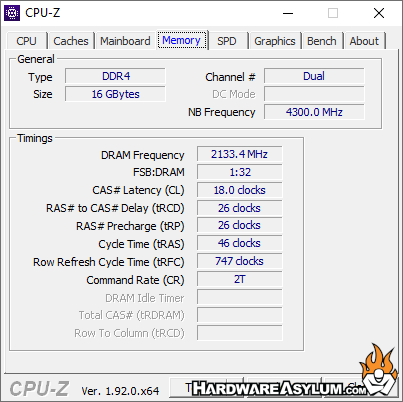Patriot Viper Gaming 4266Mhz 16GB Blackout Edition Memory Review
Author: Dennis GarciaBenchmarks - Synthetic
ASUS Maximux XII Hero – Z490 Chipset
Intel Core i9 10900k (3.7Ghz) Deca Core 10 x 32KB L2 Cache 10 x 256KB L3 Cache 20MB
Thermaltake Water 2.0 Extreme
1x nVidia RTX 2080 Super
Crucial MX500 500GB SSD
HP dvd1260i Multiformat 24x Writer
Thermaltake Toughpower Grand 1050 Watt PSU
Windows 10 Pro 64bit
Memory Tested
2x Patriot Viper Blackout Edition PC4-34100 16GB DDR4
XMP #2 @ 4266Mhz (18-26-26-46)
XMP #1 @ 4133Mhz (19-21-21-41)
Reference Tested
2x Patriot Viper Blackout Edition PC4-28800 64GB DDR4 (18-20-20-40)



Sandra is a software collection of synthetic benchmarks that will give us a basic idea as to what a system is capable of. It should be noted that SiSoft numbers change depending on what hardware is being tested. These were recorded using Sandra Professional Version 30.29.2020.5


AIDA64 Extreme Edition is a streamlined diagnostic and benchmarking software package designed to assist with overclocking and general system tuning. The package also contains modules to assess the performance of the processor, system memory, and disk drives in addition to normal stuff like stress testing and troubleshooting.


Unigine is a synthetic benchmark much like 3DMark Vantage, but supports the newest of DirectX 11 technologies. The benchmark comes with lots of heavy tessellation and soft shadows to work the more flexible shaders found on DirectX 11 graphic cards. This makes this benchmark ideal for seeing exactly what a best case scenario might look like for a DirectX 11 capable GPU.
Benchmark Settings
HWBot Benchmark
DirectX 11 Presets
DirectX 9 Presets

SYSmark 25 is an application-based benchmark that reflects usage patterns of business users in the areas of Productivity, Creativity and Responsiveness. The new Productivity Scenario has updated workloads and applications geared towards office centric user activities. The new Creativity Scenario features updated workloads and applications geared toward media-centric user activities. The new Responsiveness Scenario models ‘pain points’ in the user experience. These common activities that include: application launches, file launches, web browsing with multiple tabs, multi-tasking, and background application installation.


PCMark 10 is an overall system benchmark to measure and compare PC performance using real-world tasks and applications. Similar to 3DMark this new version tests the entire system as a whole using applications that reflect typical PC use in the home and at the office. This approach ensures that PCMark measures the things that matter, highlighting performance differences that will be apparent to end users and consumers.

When you are dealing with performance memory modules you basically have two modes to choose from. You have the JEDEC mode which is the default and you get without any BIOS modifications and will offer stable operation but not much in the way of performance.
Enabling XMP is by far the fastest way to increase system performance and was the basis of this review. To give these numbers some context I ran the 16GB modules in both XMP profiles against the 64GB 3600Mhz kit. While the overall major difference is frequency it would seem that total capacity helped in a few of the real world benchmarks.
As they say in the automotive world, there is no replacement for displacement. In the computer world this translates to the performance gained from having faster memory despite the processor and subsystem remaining the same. As expected the gains are somewhat small. You can clearly see the latency penalty associated with higher density modules and the performance gain you can expect in games.
While on paper and in synthetic form the 4266Mhz modules clearly come out on top but, it is interesting to see how subtimings can often make a slower frequency be more efficient.

